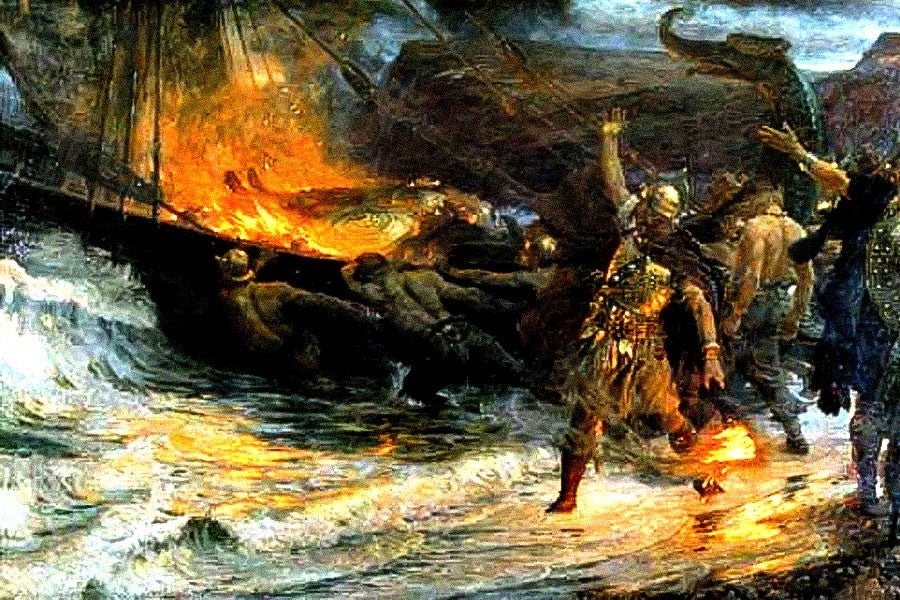The final scene of the epic 1958 adventure flick The Vikings goes something like this: The corpse of Prince Einar (Kirk Douglas) is carried onto a longship by four decorated Viking warriors. A shield is placed above his head, the massive striped sail drops into place and a single archer fires a flaming arrow aboard. As the ship is cast adrift, a band of archers opens fire, sending a volley of flaming arrows into the ship. The music swells, the sun sets and the vessel floats toward the horizon, fully engulfed in flames (uh, spoiler alert, we guess).
After watching this scene, my 10-year-old self resolved to have a Viking funeral of my own when the time came. Years later, this resolve became even stronger when GWAR fans and bandmates paid their respects to late frontman Dave Brockie by holding a Viking funeral for his alter-ego, Oderus Urungus.
So you can imagine how devastated I was when I recently stumbled upon a Reddit post questioning the legality of such a ceremony. Having never considered the fact that my dream funeral might be illegal, my heart sank as I scrolled through the comments: The general consensus was that you might get away with a Viking funeral if the remains are already cremated and the boat is on your own property (one English coffinmaker actually hand-crafts miniature longships for this exact purpose). But alas, that goes against everything I’ve ever wanted from my own send-off.
I did some research, and as it turns out, I’ll never get the chance to have a Viking funeral of my own, because firing a flaming arrow onto a boat loaded with a dead body is (1) completely and utterly illegal; and (2) not something that the Vikings actually did anyway.
It’s true: Rather than burning their (extremely valuable) longships every time a person died (which, in those days, happened all the fucking time), the Vikings usually cremated their dead upon a funeral pyre, believing that the smoke would carry their soul to Valhalla. Occasionally, very high-ranking Vikings were buried alongside ships and grave goods, i.e., gifts thought to accompany the dead into the afterlife (their slaves were even sacrificed to escort their deceased masters to Valhalla). The famous Oseberg burial mound, for instance, contained a massive longship, numerous ornaments and two female skeletons (one of which probably belonged to a queen or a priestess).
But as if historical accuracy weren’t enough of a reason to ruin my dreams of going out like a Viking, placing a corpse onto a ship, then lighting said ship on fire, is — as mentioned earlier — 1,000 percent illegal. “Unfortunately, the laws are pretty clear on what constitutes ‘disposition’ (the final place for a human body),” explains funeral director and funeral home owner Jeff Jorgenson. “While, in principle, cremation comes close to a Viking-style funeral, the regulations stipulate the type of facility, machinery and licensure/permitting that the facility and their operators must comply with. ‘On a boat somewhere in a navigable waterway’ isn’t one of those.”
https://www.youtube.com/watch?v=R_wnVzxOuic
Worse yet, these Hollywood-style Viking funerals are also massively impractical: Cremating a human body can take up to three hours in a 1,400 to 1,800 degree Fahrenheit cremation chamber, and the average boat fire simply wouldn’t burn hot or long enough to transform flesh and bone into ash. “If you tried to recreate this, you would have bits of the deceased washing ashore, partially burned, for the living to find in a greasy, charred slick of flotsam and jetsam,” Jorgenson emphasizes. “The choking fumes and anticlimactic sputtering of a fire out on the water would leave the onlookers with a decided sense of, ‘Oops,’ not high-fives and, ‘Hell yeah!’ They would certainly not feel a sense of healing or closure. For this reason, there’s nowhere in the world where anything like the Hollywood version is practiced — it isn’t practical or realistic.”
Put simply, creating a Hollywood-style Viking funeral would be both a disgusting and traumatizing experience. “Disposing of the dead is serious business that requires the efforts to actually complete the task — to get the dead person out of public view and smell… permanently,” Jorgenson says. “While the notion of a Viking funeral smacks at reverence, the margin for error if it weren’t engineered perfectly, would have quite the opposite effect.”
Welp, I guess tossing me in the trash is also out of the question, then…

